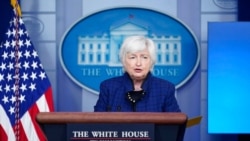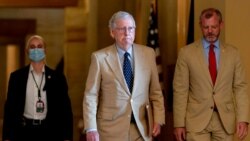Unless Congress votes to increase the amount of money the U.S. Treasury is allowed to borrow above its current debt of $28.5 trillion, the United States will default on its financial obligations sometime in the next several weeks, experts warn.
Few experts consider that likely to happen, but if it did, it could trigger an economic catastrophe with effects far beyond America's shores.
In a letter to members of Congress last week, Treasury Secretary Janet Yellen warned of the damage that would result if the U.S. is unable, even for a short time, to pay its bills.
"A delay that calls into question the federal government's ability to meet all its obligations would likely cause irreparable damage to the U.S. economy and global financial markets," wrote Yellen, the former chair of the Federal Reserve Board. "At a time when American families, communities, and businesses are still suffering from the effects of the ongoing global pandemic, it would be particularly irresponsible to put the full faith and credit of the United States at risk."
With that crisis looming, Democrats and Republicans in Washington are battling over who should take responsibility for the politically unpopular task of raising the cap on borrowing, commonly known as the debt limit. Republicans, led by Senate Minority Leader Mitch McConnell, have vowed that not a single one of them will vote to raise the limit.
For their part, Democrats say that much of the spending the increased debt would finance is the result of policies passed by a Republican-led Congress and signed by a Republican president, Donald Trump. Therefore, they argue, the GOP should participate in raising the limit.
'America must never default'
The strange thing about the current debate is that there is absolutely no disagreement between the parties about what should happen. In an interview with the Louisville Courier-Journal in his home state of Kentucky last week, McConnell was explicit, saying that "America must never default" and "the debt ceiling needs to be raised."
However, McConnell said, Republicans will not provide any votes to make that happen. What he is demanding the Democrats do is raise the debt limit unilaterally, using a process called "budget reconciliation," which would make it impossible for Senate Republicans to block a vote on the measure.
McConnell's stance has angered Democrats, who point out that enforcement of the debt ceiling was suspended three times during the four years of the Trump presidency, each time with Democratic support for allowing the debt to rise.
Possible House vote next week
House Speaker Nancy Pelosi, a California Democrat, has ruled out the possibility of including a debt ceiling increase in a reconciliation package, creating what appears to be an impasse on Capitol Hill.
On Friday, House Majority Leader Steny Hoyer, a Maryland Democrat, said the House would vote on a measure to raise the debt ceiling next week. House Democrats could opt to tie the debt limit measure to a must-pass spending bill that would avert a government shutdown when the fiscal year ends on September 30, upping the significance of Republican opposition.
If the House bill passes, it would move to the 50-50 Senate, where Democrats have a bare majority because Vice President Kamala Harris can cast a tiebreaking vote. Such a measure, however, would be susceptible to a Republican filibuster if GOP lawmakers choose to block it.
'Who blinks first?'
Many in Washington believe the debt ceiling will be raised before the U.S. defaults, but they aren't sure of the mechanism. Yet lawmakers have come dangerously close to defaulting in the past. In 2011, when House Republicans battled with Democratic President Barack Obama over the federal debt, the bond rating firm Standard & Poor's issued the first-ever downgrade of U.S. sovereign debt, sparking a major stock market sell-off.
"We know what's going to happen, but we don't know how it's going to happen," said Marc Goldwein, senior vice president and senior policy director for the Committee for a Responsible Federal Budget, a government spending watchdog. "At the end of the day, one way or another, politicians will raise or suspend the debt limit. The United States cannot and will not default on its obligations. And so somebody is going to budge. But the question is, who blinks first?"
There are multiple ways this could play out, said Richard Kogan, a senior fellow at the Center on Budget and Policy Priorities.
"Congress could enact a debt limit increase or a new suspension, and the amount of that increase or the duration of the suspension could be debatable," he said. "Congress could choose to add other conditions, but doing so has not been the standard in recent years, for good reason. And it is possible that for political reasons Republicans in Congress will allow this to be done, but only with Democratic votes."
New borrowing necessary
Until August 2, the country had been operating under the latest of a series of suspensions of the debt ceiling that allowed the Treasury to issue new debt without restrictions. When the suspension was lifted, the government's debt stood at an estimated $28.5 trillion.
That represented an increase of about $6.5 trillion since 2019, the last time the limit was suspended, and about $8.6 trillion since a suspension that took effect in the first months of the Trump administration.
Most of the increase in federal debt since 2017 happened under the Trump administration, but a significant part of it, mainly in pandemic relief legislation, was signed into law by President Joe Biden.
Since August, the Treasury Department has engaged in a series of "extraordinary measures" to avoid defaulting on obligations without additional borrowing. However, Treasury officials have said those measures will become unsustainable sometime next month.
Pressure campaign
The Biden administration has been trying to increase the political pressure on McConnell and congressional Republicans to force them to participate in a debt limit increase.
On Wednesday, Yellen spoke with McConnell on the phone. The White House said the purpose of the call was to "convey what the enormous dangers of default would be." But a spokesperson for McConnell made it clear that the conversation had not moved the Republican.
"The leader repeated to Secretary Yellen what he has said publicly since July," the spokesperson said. "They will have to raise the debt ceiling on their own, and they have the tools to do it."
On Friday, The Associated Press reported that the administration had been reaching out to state and local government leaders to warn them about interruptions in federal funding that could result if the limit wasn't raised.
Debt limit history
The debt limit was not designed to be used as a political cudgel. Its origins go back to World War I, when Congress pre-authorized a certain level of debt so the Treasury would not have to seek congressional authorization every time it needed to issue new bonds.
Since 1917, when it was created, the debt limit has been raised many times. According to the Treasury Department, since 1960, Congress has acted to "raise, temporarily extend, or revise the definition of the debt limit" 78 times.
It is only in recent decades, as federal borrowing has accelerated, that raising the debt limit has become a political weapon.









